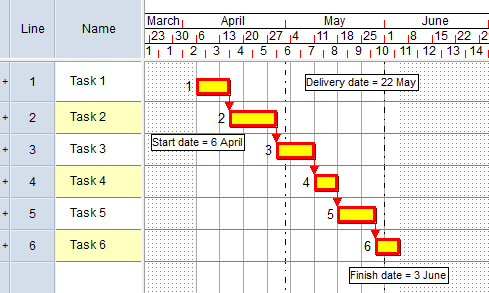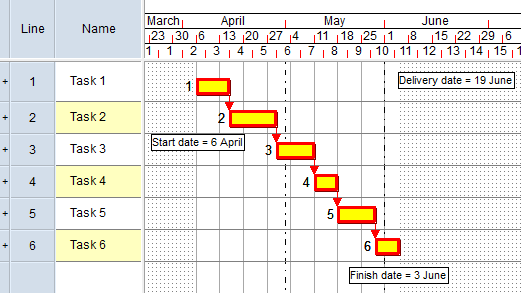'Critical path length index' quality metric
Use the 'critical path length index' metric to check whether the delivery date of a project is in danger of being missed. This metric divides the elapsed duration between the project start and the delivery date by the elapsed duration between the start and finish of the project to determine the ratio between these values. This ratio is the critical path length index. A ratio less than 1 can indicate that the delivery date is in danger of being missed as the schedule is over-running.
Elapsed duration between project start and delivery date / Elapsed duration between project start and project finish = Critical path length index
To use this metric, you must specify a delivery date against the programme of projects and/or against individual charts or summary tasks that represent projects.
This metric meets the requirements of DCMA test 13 (Critical path length index (CPLI)).
In the following illustration, the project start date is 6th April, the delivery date is 22nd May and the project finish date is 3rd June:

In this project, the critical path length index is 0.79 (46d / 58d = 0.79). With the pass boundary set to 1.00 and the fail boundary set to 0.95, the project would fail this metric, as the delivery date is earlier than the finish date of the project.
The following illustration shows the same project, but with the delivery date moved to 19th June:

The critical path length index is now 1.28 (74d / 58d = 1.28). With the pass boundary set to 1.00 and the fail boundary set to 0.95, the project would now pass the metric, as the delivery date is later than the finish date of the project.
You can change the impact that this metric has on the weighted total result of a quality check by entering a factor by which the quality metric should be multiplied in the Weighting field. For the weighting to have any effect, a quality check must have more than one quality metric.
As this metric results in a ratio rather than a percentage (where any ratio greater than 1 is a desirable result), the ratio is turned into a percentage for weighting purposes by multiplying it by 100; any resulting percentages greater than 100% are reduced to 100%. The resulting percentage is multiplied by the weighting factor you specify.
Pass and fail criteria
| Pass or fail? | Criteria |
|---|---|
| Pass |
A project passes this metric if the critical path length index is greater than or equal to the pass boundary.
For example, if the pass boundary was set to 1.00, a project would pass this metric if the ratio was 1.00 or greater. |
| Fail |
A project fails this metric if the critical path length index is less than the fail boundary.
For example, if the fail boundary was set to 0.95, a project would fail this metric if the ratio was less than 0.95. |
| Neither pass nor fail | If the critical path length index falls between the pass and fail boundary, the result is neither a pass nor a fail, but somewhere in between. |
Suggested settings to meet the requirements of DCMA test 13 (Critical path length index (CPLI))
- Pass boundary: 1.00. A project will pass this metric if the critical path length index is 1.00 or greater.
- Fail boundary: 0.95. A project will fail this metric if the critical path length index is less than 0.95.
The following table shows whether some example projects would pass or fail this metric using these settings:
| Critical path length index | Pass or fail? |
|---|---|
| 0.00 | Fail |
| 0.50 | Fail |
| 0.94 | Fail |
| 0.95 | Neither pass nor fail |
| 0.99 | Neither pass nor fail |
| 1.00 | Pass |
| 2.00 | Pass |
Does the metric force a project to be rescheduled?
No.
Suggested actions if a project fails this metric
You could take the following actions if a project fails this metric:
- Review the project's delivery date to determine whether it is realistic; if it is not, change the delivery date to a more realistic date in the future.
- Review the tasks on the critical path to determine whether there is any way of shortening the critical path.